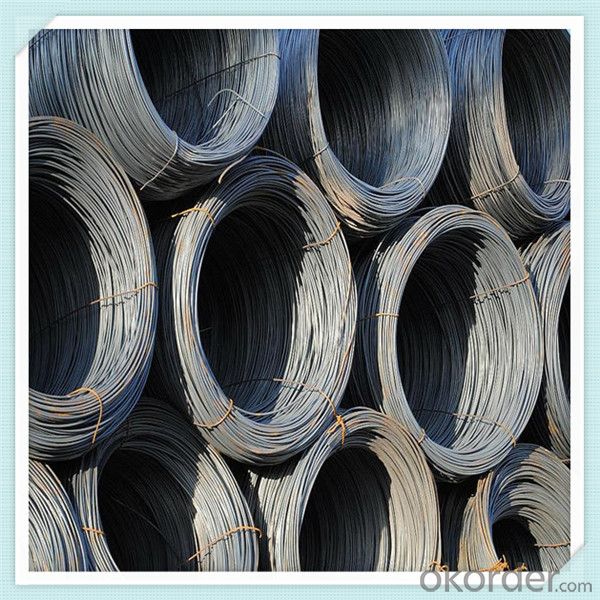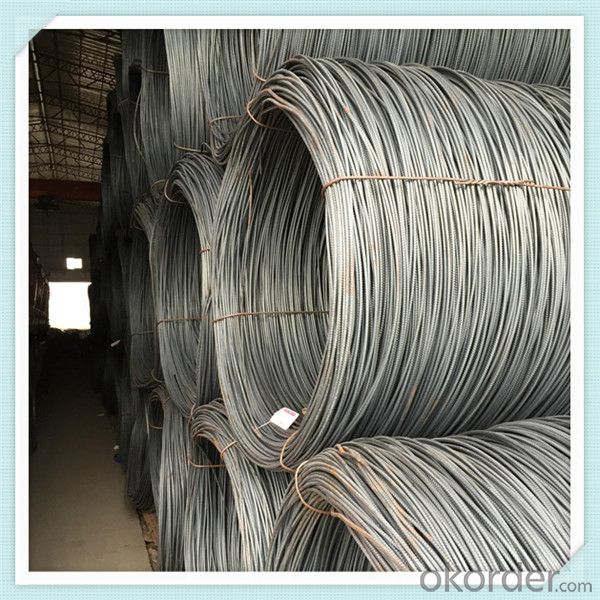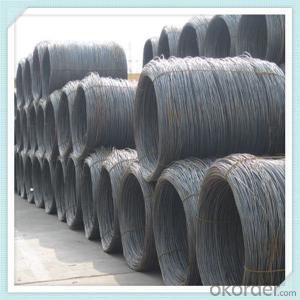SAE1012 Steel wire rod directly from China mill
- Loading Port:
- Qingdao
- Payment Terms:
- TT OR LC
- Min Order Qty:
- 100 m.t.
- Supply Capability:
- 18100 m.t./month
OKorder Service Pledge
OKorder Financial Service
You Might Also Like
Item specifice
Features
1、Pure steel quality, stable chemical contents, small tolerance.
2、Constant Quality, good drawing performance.
3、High dimension accuracy degree, accuracy degree of Level C up to 80%, smooth surface, less scale,
easy to be pickled.
4、Automatic bundling with 4 lines by Machine in tidy and good looks
5、Big high quality percentage, small coil percentage, and heavy coil weight for Hard Coil.
6、High sorbitizing percentage.
Wire rod is used for many different products. Depending upon how it is cold formed and heat treated, wire
is used, for example, to produce not only wire ropes, barbed wire, wire mesh and nails, but also springs,
welded wire mesh and reinforcement wire.
Product Description :
Standard | AISI, ASTM, BS, DIN, GB, JIS |
Material/steel grade | Q195-Q235,SAE1006B,SAE1006CR, SAE1008B, SAE1008CR, SAE1010B, SAE1018B, or according to customers requirements |
Wire Gauge | 5.5-12mm |
Coil weight | 1.8-2.1mts |
MOQ | 25MT |
Delivery Time | 15-30 days after receipt of L/C or deposit by T/T |
Packing | In coil and load in container, if large quantity, by bulk vessel; Can be packed as customers' special requirements |
Payment terms | 1).100% irrevocable L/C at sight. 2).30% T/T prepaid and the balance against the copy of B/L. 3).30% T/T prepaid and the balance against L/C |
Application | widely used in machinery parts, manufacturing industry, electronics industry, metal tools and others |


Application :
It generally used in braiding the hose for bathing product and machinery. With it
good flexibility, resistant to high temperature and resistant to corrosion, it
used widely in many industries.
Packing :
Hot-rolled wire rod is held in a unit with at least four steel straps in the
transverse direction and transported and stored without further packaging.
Before
the steel strapping is applied, the wire rod must be sufficiently compressed.
The strapping is fixed in the transverse direction with a single circumferential
strap so that the strapping does not slip and cause the coil to come apart.


Our service:
(1) We cooperate with famous factories with advanced equipment and well trained workers.
(2) We can provide factory price with trading company service.
(3) We continuously work on the improvement of our processes, guaranteeing
consistently high standards of quality to keep none compensation.
(4) We guarantee 24 hours response and 48 hours solution providing service.
(5) We accept small order quantity before formal cooperation.
(6) We deliver the agreed quality at the agreed time, reacting to changes in
customer wishes in a flexible way.
(7) Due to our volume and selling power, we have excellent freight rates with
shipping lines.
(8) We strive to always be fair and honest in our dealings with customers.
(9) We strive to work together with customers to achieve much more than we can
achieve alone.
(10) Through our passion and commitment we aim to be a market leader in all our
key markets. To maintain our position as market leader we must continue to add
value in all that we do.
FAQ:
1.Q: What's your MOQ(minimum order quantity)?
A: One full container, mixed acceptable .
2. Q: What's your packing methods?
A: Packed in bundle or bulk ..
3. Q: How can I buy CNBM products in my country?
A:Please send us an inquiry or email ,we will reply to you if there is distributor in your country
4. Q: Can we visit your factory?
A: Warmly welcome. Once we have your schedule, we will arrange the
professional sales team to follow up your case.
5. Q: How long does it take to get the product if i place an order?
A:With the process of your requirements,we will pack and deliver in 3
-7 days. If it is by sea shipment,it will take 15-45 days depending on different locations
- Q:What are the main factors influencing the choice of steel wire rod order payment method options?
- The main factors influencing the choice of steel wire rod order payment method options include the financial stability and trustworthiness of the buyer and seller, the volume and frequency of orders, the level of risk involved, the availability of financing options, the buyer's creditworthiness, and any contractual obligations or industry standards.
- Q:Can steel wire rod be used for welding applications?
- Indeed, welding applications can incorporate steel wire rod. As a filler material, steel wire rods are frequently employed in welding procedures. Generally composed of low carbon steel, they come in diverse sizes and grades to cater to distinct welding necessities. Steel wire rods can be put to use in various welding applications, including arc welding, MIG welding, TIG welding, and spot welding. When utilized correctly, they yield a sturdy and dependable weld. Nonetheless, it is crucial to meticulously choose the suitable wire rod, taking into account the metal type being welded and the specific welding technique employed.
- Q:How is the steel wire rod market affected by changes in trade policies?
- Changes in trade policies can have a significant impact on the steel wire rod market. Trade policies such as tariffs or quotas can influence the supply and demand dynamics, production costs, and competitiveness of steel wire rod producers. When trade policies impose tariffs on steel wire rod imports, it can increase the cost of importing the product, making it more expensive for domestic manufacturers to source raw materials. This can lead to an increase in the price of steel wire rod in the domestic market, affecting the profitability of manufacturers and potentially reducing the demand for the product. Conversely, if trade policies impose tariffs on steel wire rod exports, it can limit the market access for domestic manufacturers, reducing their ability to sell their products internationally and potentially impacting their revenue. Quotas on steel wire rod imports can also have a significant impact on the market. When quotas are imposed, it limits the quantity of imported steel wire rod that can enter the domestic market. This can lead to a decrease in supply, potentially creating a shortage in the market and driving up prices. On the other hand, if quotas are imposed on steel wire rod exports, it may restrict the ability of domestic manufacturers to access international markets, reducing their market reach and potentially affecting their profitability. Changes in trade policies can also impact the competitiveness of domestic steel wire rod producers. If trade policies favor domestic producers by imposing higher tariffs on imports, it can provide a competitive advantage to domestic manufacturers by making imported steel wire rod more expensive. This can incentivize domestic production and potentially lead to increased investment in the industry. Conversely, if trade policies favor imports by imposing higher tariffs on exports, it can hinder the competitiveness of domestic producers, making it difficult for them to compete in international markets. Overall, changes in trade policies can have both positive and negative impacts on the steel wire rod market. The extent of these impacts depends on the specific trade policies implemented and the reactions of market participants.
- Q:How is steel wire rod tested for internal defects?
- Steel wire rod is tested for internal defects using non-destructive testing methods such as ultrasonic testing or electromagnetic testing. These techniques involve passing high-frequency waves or electromagnetic fields through the rod to identify any internal flaws or defects. By analyzing the reflected waves or electromagnetic signals, any hidden defects such as cracks, voids, or inclusions can be detected, enabling manufacturers to ensure the quality and integrity of the steel wire rod.
- Q:How is the fatigue resistance of steel wire rod tested?
- The fatigue resistance of steel wire rod is commonly assessed through a cyclic loading test known as the rotating bending fatigue test. In this particular test, a sample of the steel wire rod is subjected to repetitive bending under controlled circumstances. The test commences by affixing the sample onto a rotating mechanism, such as a rotating beam or wheel. Subsequently, the sample is exposed to a cyclic bending load that fluctuates in both magnitude and direction. This load is exerted by a mechanical or hydraulic device that consistently applies the bending force to the sample at a fixed frequency. Throughout the test, close attention is paid to the number of cycles and the stress or load applied. Generally, the test is continued until the sample fails due to fatigue, which encompasses the development of cracks, fractures, or permanent deformation. The number of cycles needed for failure is recorded as the fatigue life of the steel wire rod. To ensure accurate testing, multiple samples are typically evaluated under various stress levels or load amplitudes. This enables the determination of the fatigue strength of the steel wire rod, often expressed as the stress amplitude capable of enduring a specified number of cycles without failure, such as 10^6 cycles. All in all, the rotating bending fatigue test yields valuable insights into the fatigue resistance of steel wire rod, allowing manufacturers and engineers to assess its durability and suitability for diverse applications.
- Q:What are the different types of steel wire rod processing equipment?
- In the manufacturing and production process, various types of steel wire rod processing equipment are utilized. These equipment have been designed to carry out different tasks and processes, with the aim of converting raw steel wire rods into finished products. Among the diverse range of steel wire rod processing equipment are the following: 1. Wire Drawing Machines: These machines function by pulling the wire rod through a series of dies, resulting in a reduction in diameter. This process enhances the wire's surface finish, accuracy, and strength. 2. Wire Straightening and Cutting Machines: These machines are utilized to straighten and cut the wire rod into desired lengths. They are capable of handling different wire diameters and are commonly employed in the production of wire products such as nails, screws, and wire mesh. 3. Wire Annealing Furnaces: For the purpose of softening the wire rod and improving its ductility and machinability, annealing is employed as a heat treatment process. Annealing furnaces provide controlled heating and cooling conditions, facilitating the attainment of the desired properties. 4. Wire Coiling Machines: These machines are responsible for winding the straightened and cut wire rod into coils. Depending on the volume and size of the coils required, they can be either manual or automated. 5. Wire Galvanizing Lines: In order to protect the wire rod from corrosion, a layer of zinc is applied to its surface through the process of galvanizing. Galvanizing lines are employed to clean, flux, and coat the wire rod with molten zinc. 6. Wire Electroplating Equipment: Electroplating is a technique employed to deposit a thin layer of metal onto the surface of the wire rod, with the purpose of enhancing its appearance or providing specific properties. Electroplating equipment encompasses tanks, rectifiers, and various chemical solutions. 7. Wire Mesh Welding Machines: These machines are utilized to weld the wire rods together, creating wire mesh products such as fences, reinforcement grids, and filter screens. The level of automation varies depending on the complexity of the mesh design. 8. Wire Stranding Machines: In the production of electrical cables and conductors, stranding machines are employed to twist multiple wire rods together, resulting in stranded cables. In conclusion, the diverse range of steel wire rod processing equipment plays a critical role in the manufacturing and production of various wire and steel products. These machines enable the conversion of raw materials into finished products that possess the desired properties and meet the required specifications.
- Q:How is steel wire rod used in the manufacturing of wire forms for automotive components?
- Steel wire rod is an essential component in the manufacturing of wire forms for automotive components. Wire forms are intricate shapes and designs made from metal wire, and they play a crucial role in various automotive applications such as springs, clips, brackets, and fasteners. The process begins with steel wire rods, which are typically made from carbon or alloy steel. These rods serve as the raw material for wire drawing, which is the primary method used to produce wire forms. Wire drawing involves pulling the steel wire rod through a series of dies to reduce its diameter and increase its length. This process helps to improve the wire's tensile strength and surface finish, making it suitable for automotive applications. Once the desired wire diameter is achieved through wire drawing, it is then fed into specialized machinery to create different wire forms. This machinery includes automated CNC (Computer Numerical Control) machines that can bend, shape, and cut the wire according to precise specifications. These machines use different tools and dies to form wire into the desired shape, ensuring accuracy and consistency. Wire forms manufactured from steel wire rod offer several advantages for automotive components. Firstly, steel wire rods provide excellent strength and durability, making them suitable for handling the demanding conditions within automotive systems. They can withstand high temperatures, vibrations, and mechanical stresses, ensuring the wire forms maintain their structural integrity over time. Moreover, steel wire rods offer flexibility in terms of design and customization. Manufacturers can easily create wire forms of various sizes, shapes, and configurations to meet the specific requirements of different automotive components. This versatility allows for the production of wire forms that are tailored to fit the precise needs of the automotive industry, enhancing the overall performance and functionality of the components. Additionally, steel wire rods are cost-effective and readily available, making them a preferred choice for wire form manufacturing in the automotive sector. The abundance of steel as a raw material ensures a stable supply chain, allowing manufacturers to meet the high demands of the automotive industry efficiently. In conclusion, steel wire rod is a crucial component in the manufacturing of wire forms for automotive components. Through the process of wire drawing and specialized machinery, steel wire rods are transformed into intricate shapes and designs that provide strength, durability, and flexibility. This enables the production of wire forms that meet the stringent requirements of automotive applications, ultimately contributing to the overall functionality and performance of automotive components.
- Q:What are the types of surface coatings applied to steel wire rod?
- There are several types of surface coatings that can be applied to steel wire rods, including galvanized, zinc-coated, plastic-coated, and epoxy-coated coatings.
- Q:What are the different types of wire mesh for filtration made from steel wire rod?
- There are several types of wire mesh for filtration made from steel wire rod, including woven wire mesh, welded wire mesh, and expanded metal mesh. Each type has its own unique characteristics and applications in filtration systems.
- Q:What are the different surface finishing techniques for steel wire rod?
- Some of the different surface finishing techniques for steel wire rod include galvanizing, electroplating, phosphating, and powder coating.
1. Manufacturer Overview |
|
|---|---|
| Location | |
| Year Established | |
| Annual Output Value | |
| Main Markets | |
| Company Certifications | |
2. Manufacturer Certificates |
|
|---|---|
| a) Certification Name | |
| Range | |
| Reference | |
| Validity Period | |
3. Manufacturer Capability |
|
|---|---|
| a)Trade Capacity | |
| Nearest Port | |
| Export Percentage | |
| No.of Employees in Trade Department | |
| Language Spoken: | |
| b)Factory Information | |
| Factory Size: | |
| No. of Production Lines | |
| Contract Manufacturing | |
| Product Price Range | |
Send your message to us
SAE1012 Steel wire rod directly from China mill
- Loading Port:
- Qingdao
- Payment Terms:
- TT OR LC
- Min Order Qty:
- 100 m.t.
- Supply Capability:
- 18100 m.t./month
OKorder Service Pledge
OKorder Financial Service
Similar products
New products
Hot products
Related keywords



























